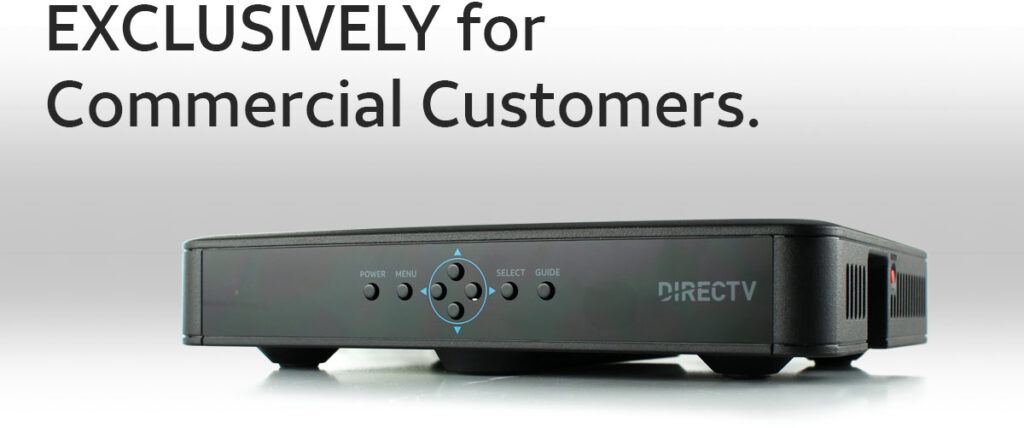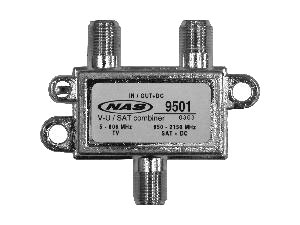Let me set the stage. You have a business, but you don’t own your building. You want DIRECTV satellite TV, and you also want to occasionally watch using an antenna. Until recently, the only thing I could tell you was that you absolutely had to run a separate line for the antenna, instead of “piggybacking” it onto a satellite cable. That’s been the standard line for about 15 years when it came to DIRECTV.
So what if I told you that there’s now a solution, but it’s only for business? Here’s what you need to know.
Let’s start with the dish itself. In most cases, businesses will use a legacy dish and bring six lines into the building. This gives the most flexibility because instead of being limited to 13 receivers, you can scale up to hundreds of receivers if you want to. However, small businesses can generally get away with the standard DIRECTV dish used in homes. This dish lets you feed 13 receivers with a single line into the building. It’s popular with businesses who rent space because not every landlord takes kindly to six new holes drilled into their walls. Landlords tend to get even more testy when you tell them that DIRECTV’s spec is to run 7 lines (one as a spare) and then an 8th line for TV antenna.
Either way you can diplex if you have a business, but to really maximize the result you’d use the standard DIRECTV dish. When you’re done, there will be one line into the building, period.

This method will ONLY work with DIRECTV’s H26K commercial receivers. All other DIRECTV boxes have network adapters that interfere with this method. If you have any other kind of DIRECTV box in your system, this will not work. You must only have H26K receivers. Since the H26K is only available for commercial customers, this method is limited only to businesses. It won’t work at home.

You’ll need a pair of these diplexers. Connect the antenna to the side that says TV, and the satellite to the side that says SAT-DC. Then run a single wire into the building. When you get closer to the satellite receivers (exactly how close is up to you and your particular need), use the same diplexer in the opposite direction. Connect the line from the SAT port into a DIRECTV splitter, and the line from the TV port into a TV splitter, then into the TV’s antenna inputs. The DIRECTV receivers can connect to the same TV using HDMI.
Here’s a diagram showing how it’s done. Note that the HDMI cables from the receivers aren’t shown, in the interest of clarity.
Diplexing-with-H26K
Click here to view fullscreen or download.
If you try this method using residential hardware, you’ll disrupt the communication between receivers. This could lead to everything from on-screen error messages to total picture loss. Just don’t do it.
On the other hand, if you have any other questions about implementing DIRECTV in your business, reach out to the experts! We’re here to help you during East Coast business hours. Call 888-233-7563, or if it’s after hours, fill out the form below.
The post HERE’S HOW YOU DO IT: Diplex over-the-air antenna into your satellite TV line… in your business appeared first on The Solid Signal Blog.
Continue reading...
So what if I told you that there’s now a solution, but it’s only for business? Here’s what you need to know.
The pieces you’ll need
Let’s start with the dish itself. In most cases, businesses will use a legacy dish and bring six lines into the building. This gives the most flexibility because instead of being limited to 13 receivers, you can scale up to hundreds of receivers if you want to. However, small businesses can generally get away with the standard DIRECTV dish used in homes. This dish lets you feed 13 receivers with a single line into the building. It’s popular with businesses who rent space because not every landlord takes kindly to six new holes drilled into their walls. Landlords tend to get even more testy when you tell them that DIRECTV’s spec is to run 7 lines (one as a spare) and then an 8th line for TV antenna.
Either way you can diplex if you have a business, but to really maximize the result you’d use the standard DIRECTV dish. When you’re done, there will be one line into the building, period.
The H26K receiver

This method will ONLY work with DIRECTV’s H26K commercial receivers. All other DIRECTV boxes have network adapters that interfere with this method. If you have any other kind of DIRECTV box in your system, this will not work. You must only have H26K receivers. Since the H26K is only available for commercial customers, this method is limited only to businesses. It won’t work at home.
The NAS STD-9501 diplexer

You’ll need a pair of these diplexers. Connect the antenna to the side that says TV, and the satellite to the side that says SAT-DC. Then run a single wire into the building. When you get closer to the satellite receivers (exactly how close is up to you and your particular need), use the same diplexer in the opposite direction. Connect the line from the SAT port into a DIRECTV splitter, and the line from the TV port into a TV splitter, then into the TV’s antenna inputs. The DIRECTV receivers can connect to the same TV using HDMI.
Here’s a diagram showing how it’s done. Note that the HDMI cables from the receivers aren’t shown, in the interest of clarity.
Diplexing-with-H26K
Click here to view fullscreen or download.
Seriously, this is only for businesses.
If you try this method using residential hardware, you’ll disrupt the communication between receivers. This could lead to everything from on-screen error messages to total picture loss. Just don’t do it.
On the other hand, if you have any other questions about implementing DIRECTV in your business, reach out to the experts! We’re here to help you during East Coast business hours. Call 888-233-7563, or if it’s after hours, fill out the form below.
The post HERE’S HOW YOU DO IT: Diplex over-the-air antenna into your satellite TV line… in your business appeared first on The Solid Signal Blog.
Continue reading...

